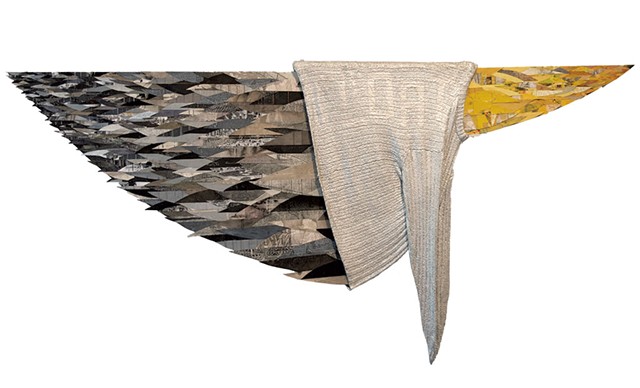
- Alice Dodge ©️ Seven Days
- "Float" by Kevin Donegan and Susan Smereka
Some couples are great at camping. Without argument, they know who carries the water, when to poke the fire, how to assemble the tent. From the outside, it looks seamlessly easy — all the more miraculous when each partner has a strong personality and a distinct idea of how their excursion should go. Susan Smereka and Kevin Donegan are surely one of those couples, although their tents, on view as part of "Fluid Dynamics2" at the Julian Scott Memorial Gallery in Johnson, did end up upside down and on the ceiling.
Smereka, primarily a printmaker, and Donegan, primarily a sculptor, met six years ago through the now-closed New City Galerie. The first show of Smereka's that Donegan saw was the original "Fluid Dynamics," which honored her late brother, a mathematician and physicist. In 2020, they founded new new art studio in Burlington's South End, where they create their work and host classes and pop-up exhibitions.
The show at the Julian Scott Memorial Gallery at Vermont State University marks Smereka and Donegan's first time making artwork collaboratively. There are no individual labels and few titles. While some works convey one artist's voice more clearly than the other's, this is a truly cohesive team installation.
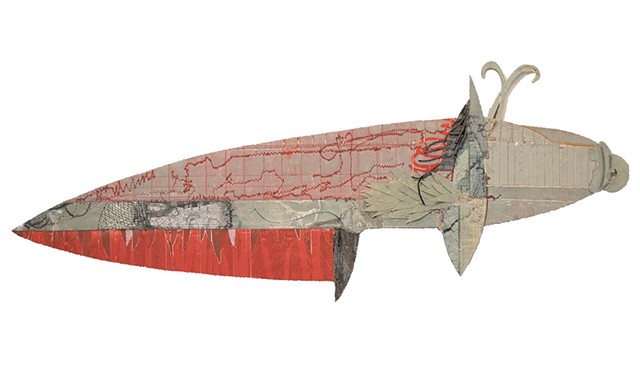
- Alice Dodge ©️ Seven Days
- "in my case" by Susan Smereka
For some time, Smereka has been using a distinctive shape in her collages and prints — she calls it a "quarter-almond shape" — that looks a bit like a tall shark fin or a fat knife blade.
"I had been thinking about family and family dynamics," she said in an interview. "I see this as a person, that shape." It became the show's central motif, popping up both on the wall and sculpturally, creating echoes that bounce around the gallery.
The most prominent instance of the "quarter-almond" appears in a collaborative piece made from two halves of a red canoe. Donegan's half is foreboding and almost erotic, with a suggestively shaped portal made of delicate metal chain framing a protruding paddle. Above it, one of the canoe's foam seats has been excavated, revealing a light switch. The viewer becomes very aware of the void within the hull.
Smereka's half, partially painted gray, is suspended from the ceiling by rusty, industrial pincers. She has woven dozens of strips of dyed purple and red fabric through the boat. They crisscross on the outside and form a hairlike mass on the inside, dangling down like seaweed.
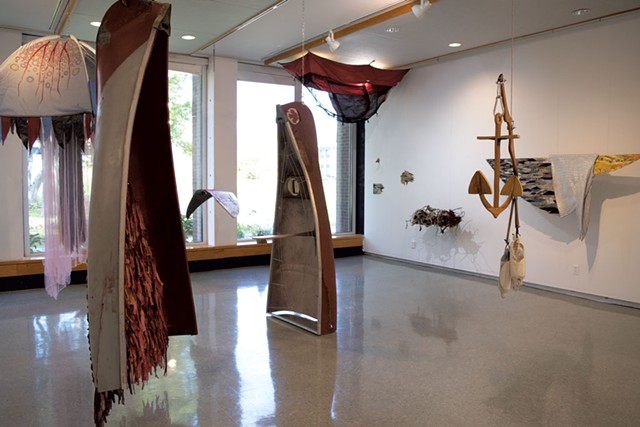
- Alice Dodge ©️ Seven Days
- Installation view
Watery allusions permeate the show. Smereka's collages are hung directly on the wall or mounted on shaped wood panels. Where she would typically align her quarter-almond shapes vertically, here she has turned them on their sides, creating an impression of fantastical sea creatures with dangling fins and fluffy appendages. On one wall, five collages together become a pod of whales.
Aesthetically, the two artists' styles are nothing alike. Smereka has a printer's eye for detail and a book artist's tactile sensibility. Donegan's sculptures are typically message driven and sometimes performative or humorous. But both artists are magpies, collecting bits and pieces that eventually make their way into the work. Smereka's collages combine and recombine bits of letters, photographs, prints, drawings, wallpaper — fragments kept sometimes for years. "Nothing is precious for too long," she said.
Donegan also uses found materials, sometimes as readymades or what he calls "nature-mades." "A lot of my work is something that any normal person would walk by or throw in the dumpster, and I'm like, Oh, my God, it's gorgeous," he said.
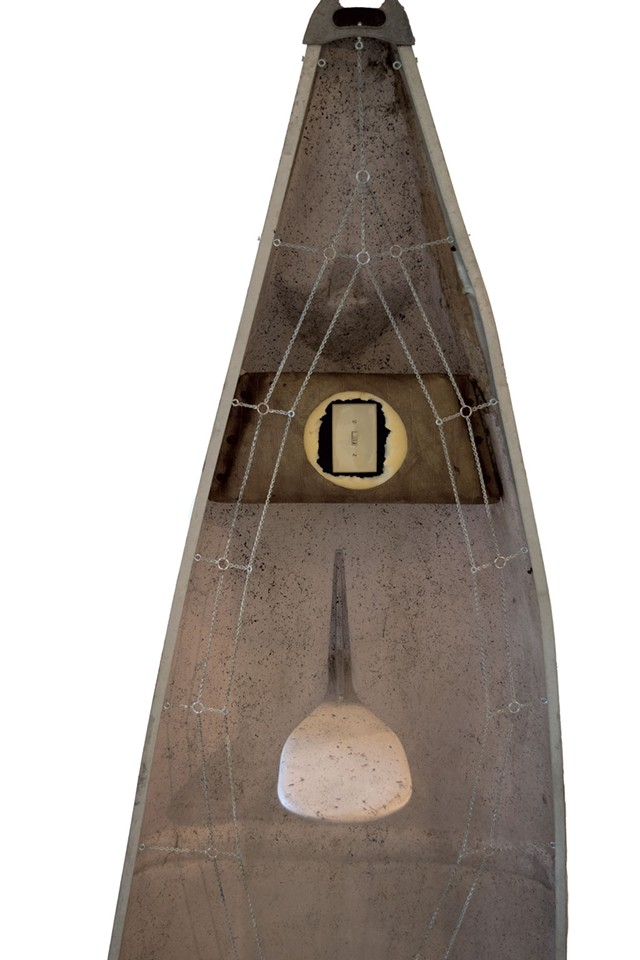
- Alice Dodge ©️ Seven Days
- Canoe detail
One such work on view is a tangle of rebar and flotsam, rescued from the shore of Lake Champlain and hanging from the ceiling. It plays off Smereka's nearby collage "versipellis," also an agglomeration of greenish-brownish pointy bits.
For some works in the show, the artists swapped materials. Donegan initiated a whole series of suspended jellyfish-like creatures, adding masses of yarn to buoys from Smereka's collection.
Other works combine their aesthetics. One piece features two off-center metal rims, almost like basketball hoops, and a pink buoy that dangles from woven fabric above into a metal net below. The color gives the buoy a bodily feel, contrasting with the metal and adding to the physical tension between the two halves.
"Float" incorporates one of Donegan's earlier works, a sweater painted silver, into Smereka's collage. Yellow on one side of the sweater, gray on the other, the accumulated shards of sewn paper include old photographs that carry the weight of history. Up close, the raised word "FLOAT" on the sweater suggests the "dead man's float" and its dark associations. Yet from a distance, the whole piece comes off lighthearted: a fat fish who's feeling a bit chilly.
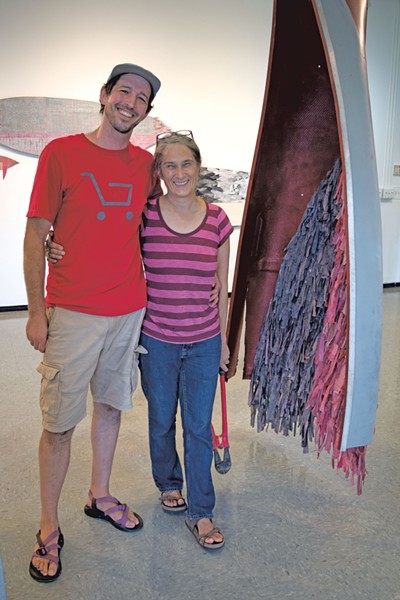
- Alice Dodge ©️ Seven Days
- Smereka and Donegan
Humor, tension and emotional weight run through the show, as well as a strong subtext of navigating family and relationships. One sculpture is especially poignant: A wooden anchor and a trio of buoys hang suspended from a yoke, taken from the canoe the artists cut in half. The buoys — typically made of rubber but here cast in plaster — overbalance the anchor.
Donegan crafted the anchor from a cracked kitchen table, a ready-made metaphor if there ever was one. Smereka made the buoys while learning plaster casting from her friend, the late artist Gregg Blasdel. Even without that context, the sculpture radiates a narrative of traumatic history; with it, the work articulates grief.
Appropriately for a collaborative show, these pieces function well in synchronicity. A suggestion in one place is reinforced visually and thematically in another, leading the viewer in all sorts of directions, from relationship dynamics to memory to (inevitably) flooding. The formal repetition of Smereka's quarter-almond shape, from the collages to the canoe to the tent sculptures, ties things together.
Ultimately, the show conveys the history of its own making: how people work together to grow new ideas. As Donegan said, "Trusting each other, and trusting that together is something different than us alone ... definitely doesn't always come easy. Sometimes it does, though, and that's also exciting."
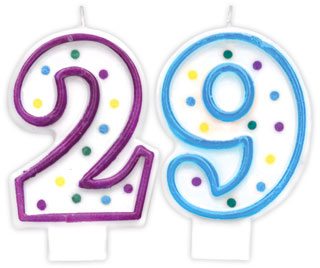






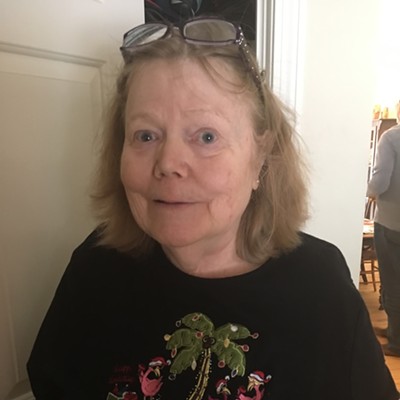
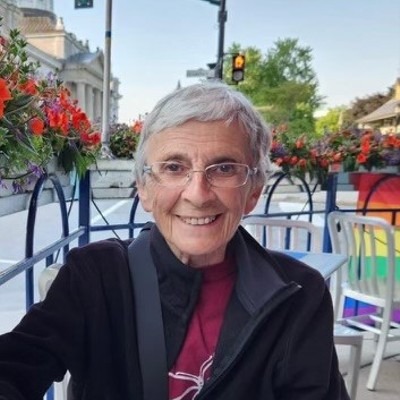
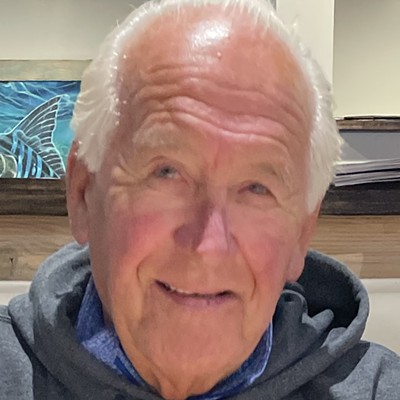

Comments
Comments are closed.
From 2014-2020, Seven Days allowed readers to comment on all stories posted on our website. While we've appreciated the suggestions and insights, right now Seven Days is prioritizing our core mission — producing high-quality, responsible local journalism — over moderating online debates between readers.
To criticize, correct or praise our reporting, please send us a letter to the editor or send us a tip. We’ll check it out and report the results.
Online comments may return when we have better tech tools for managing them. Thanks for reading.